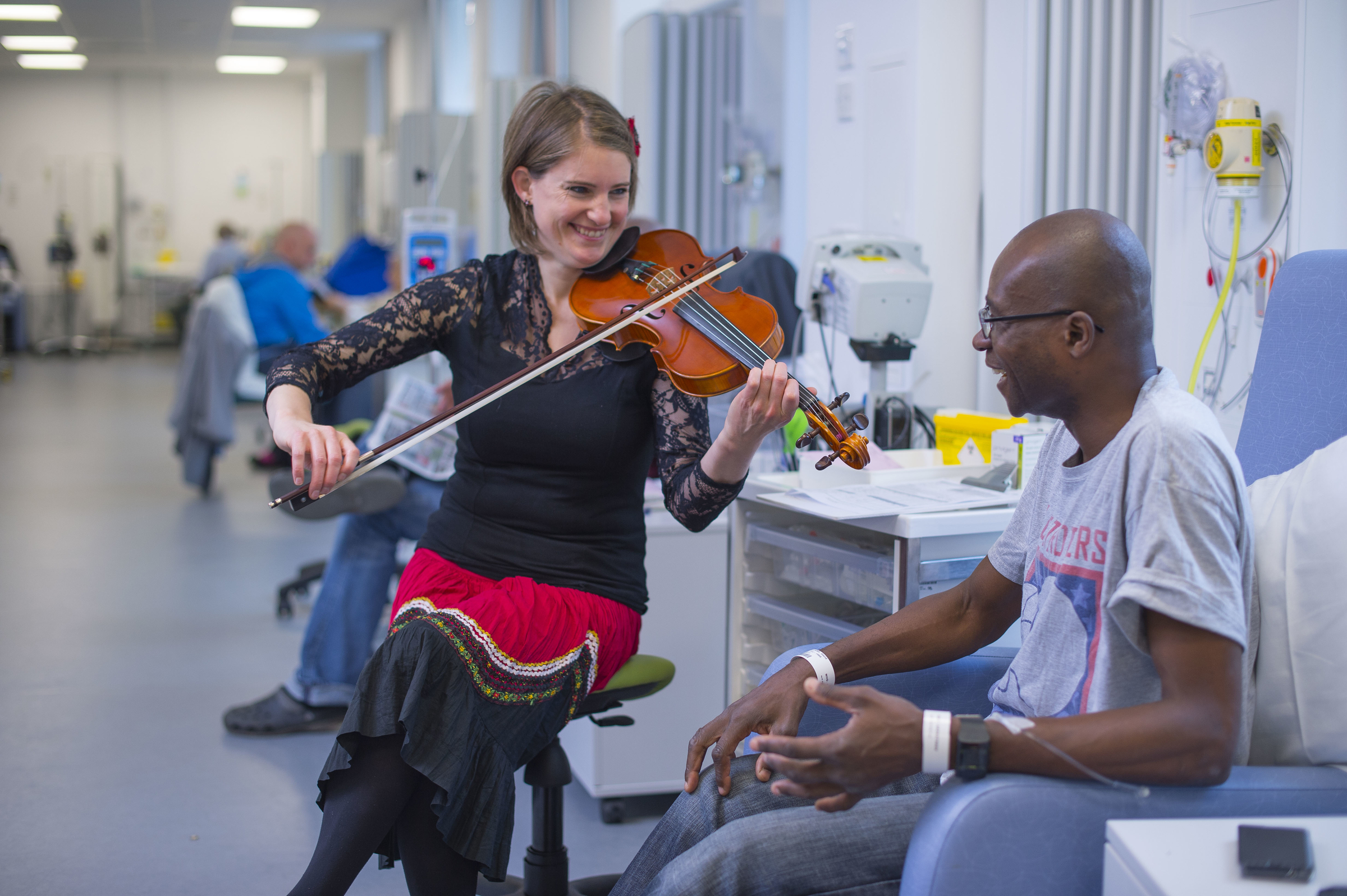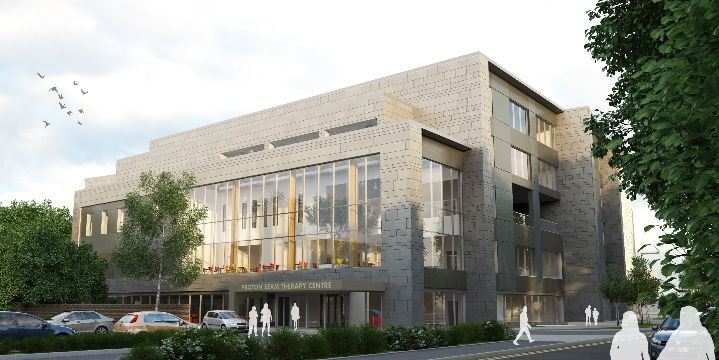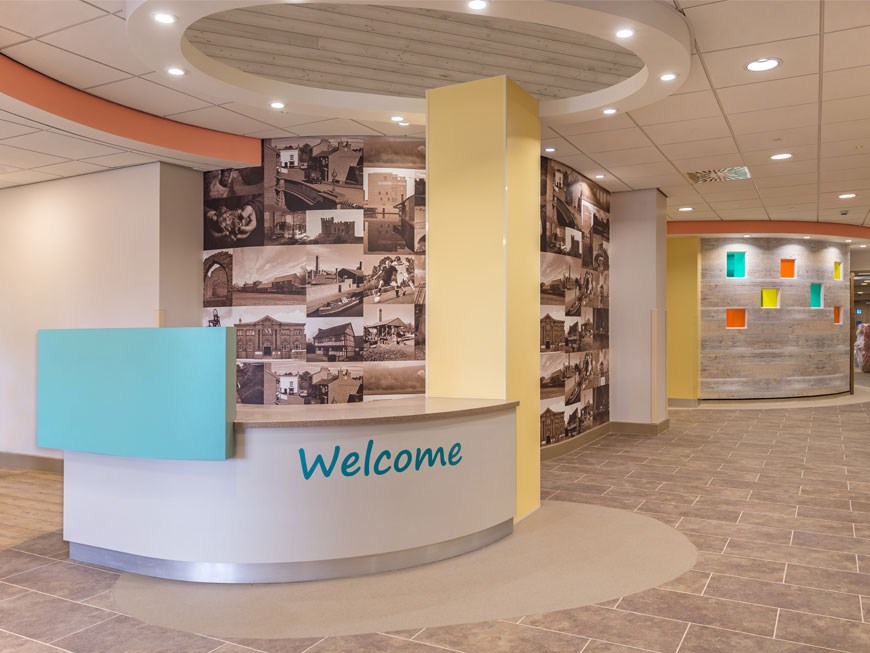As part of the 2015 Building Better Healthcare Awards, two gongs were handed out in the Special Awards category, chosen from across all 200 entries received in all classes.
The winners were chosen by our patient and clinical representatives, Danny Daniels and Dr Roy Macgregor.
Trophies were presented by celebrity host, Gethin Jones, at a ceremony last week and recognised the projects or products the judges felt made the biggest impact on clinical practice and the patient experience
Here, we profile the winners.
Clinician’s Choice Award
Winner:
Grosvenor Interiors for the Leicester General Hospital maternity bereavement suite
Eleven babies are stillborn every day in the UK, making it 15 times more common than cot death.
The impact of this tragic outcome on grieving parents – mothers in particular – is devastating and can lead to severe and costly long-term mental health problems.
At Leicester General Hospital, while staff have been well trained in handling these distressing births, their job was made more difficult by these deliveries taking place on busy maternity wards where the sound of crying babies and excited families only served to emphasis the acute loss for parents affected by stillbirths.
Feedback from parents indicated that the best solution was to provide a self-contained unit away from the main maternity ward, and that’s what Leicester General has done.
Having raised £120,000 via charitable donations, the hospital asked Grosvenor interiors to interpret and deliver the brief.
The guiding principle for Victoria Boulton, Grosvenor’s designer, was to develop a practical medical room which was comforting, safe, less like a conventional hospital and more akin to a hotel - a ‘design to cocoon the mum and put its arms around her’.
The choice of fabrics and finishes was crucial. Apart from specifying materials that conform to the highest eco-standards, the key aim was to develop a scheme that paid attention to the sensitive nature of the care being provided. This meant use of soft colours and lighting, concealing nurses’ paraphernalia and having a curtain to screen off the nursery from the recovery area, reducing the perception of the finality of a closed door.
The design also incorporated a separate access door into the nursery, allowing staff to discreetly remove the baby when the mother is ready.
To represent life ending, but also moving on, Boulton worked with the hospital’s bereavement maternity nurses and a group of mums to develop a dandelion seed head motif for the wall design.
Three rooms, with en-suite facilities, make up the new suite. ‘Sahara’ is a quiet room used to share bad news; the ‘Garden’ is the delivery suite; and the ‘Alexander Suite’ is the recovery room for the mother which has an attached nursery containing a cot equipped with a cooled mattress to stop the baby’s body deteriorating.
There is also a double bed, so fathers can stay, and a sofabed for use by other members of the family.
A private accessible garden plays an important role in the recovery process and can be used by children too young to understand.
Ward Sister, Joan Morrissey, said that working in the new suite had boosted staff morale, but, more importantly, has helped with the recovery process for bereaved parents.
One young mother said of the unit “A stillbirth is a parent’s worst nightmare. We were given the garden room, which certainly helped us deal with the difficult situation better. It was absolutely lovely and relaxing.”
Judge, Dr Roy Macgregor, described the project as ‘hugely important for all involved’.

Willis Newson was highly commended for its arts project at Southmead Hospital, Bristol
Patient’s Choice Award
Highly commended:
Willis Newson for its arts project at Southmead Hospital, Bristol
The Fresh Arts Festival was a three-day celebration of creativity and wellbeing, organised to mark the opening of Southmead Hospital’s new Brunel building.
The event aimed to improve the wellbeing of all who use the hospital, to link the hospital with local residents, and to foster a sense of community within the new development.
Run during October 2014, 24 local artists, writers, and musicians, and 11 local choirs, delivered 277 performances, workshops, and bedside activities to more than 3,200 patients, staff, visitors and local residents.
Described by one patient as ‘like being greeted by a giant hug’, the music programme, in particular, created such an impact that choirs have since returned to the hospital and a sponsored cycle raised money for a grand piano to be permanently sited in the atrium. Further funds have been set aside for a monthly programme of live music on the wards.
Other long-term benefits from the event include a knitting programme which, during the festival, resulted in over 400 squares being knitted, which were then sewn together by volunteers to create a giant jumper, which was displayed in the entrance hall. This had such an effect that North Bristol NHS Trust has since funded a year-long residency for Ali Brown to continue to deliver, develop and further evaluate the project.
The trust’s director of nursing, Sue Jones, said of the event: “We’ve designed the hospital to be a healing environment, and the arts programme has made that personal for people.
“There were choirs singing in patients’ rooms, orthopaedic doctors building model cars, and patients knitting and chatting with members of the public.
“Art can help patients to make progress and we have to keep this going.”
Judge, Danny Daniels, added: “This encapsulates how the ambience of a health resource in terms of bricks, mortar staff and equipment can be transformed with the inclusion of art from many facets.”

The Proton Beam Therapy Centre was also highly commended
Highly commended
Interserve for the Proton Beam Therapy Centre UK
The Manchester Proton Beam Therapy Centre (PTC) is the first high-energy PTC treatment facility in the NHS.
Located at The Christie Hospital, it will give patients access to this ground-breaking treatment closer to home, as currently they have to travel abroad for it.
The design concept for the building - delivered through ProCure21+ - was to integrate three important elements – namely soothing nature, human care. and healing technology. This ‘nature-care-technology’ concept formed one of the organising principals of the building’s design, and nature has been implanted directly into the patient environment.
The waiting areas provide direct contact with daylight and nature and help to reassure the inhabitants by providing views to the outside world. Adult waiting areas are contained within a ‘Winter Garden’, a light and plant-filled area directly over the building’s main entrance. A kitchen has also been integrated into this space to help create a relaxed and social setting.
Patient and community interaction is seen as a key aspect in the design, but also discrete waiting zones have been created for those seeking a more-quiet or contemplative experience.
For younger patients, dedicated areas have been provided and are located to provide segregated clinical flows and to allow access to daylight and nature. Separate external spaces include a play therapy area.
Judge, Danny Daniels, said: “The research and development phase of this project was obviously key to ensuring the end result would be a world-class development.”

The Lighthouse was the winner of this year's Patients Choice Award
Winner:
Gilling Dod Architects for The Lighthouse, West Bromwich
“The vision and realisation of this superb facility for patients suffering from dementia and their carers is truly an exemplar.”
This is the view of Danny Daniels, head judge for the Patient’s Choice Award.
He is referring to The Lighthouse, a new dementia care development in West Bromwich.
A new community resource, the facility offers support and guidance to people affected by dementia, their families, friends and carers.
Open seven days a week from 8.30am to 7pm, it incorporates a café, social and cinema room, cultural library, hairdressing salon, and a ‘living well with dementia’ demonstration area.
Each area has been designed to be dementia-friendly and to promote greater choice and independence. The environment also aims to reduce the stigma associated with the disease and to provide holistic care based on the King’s Fund’s Enhancing the Healing Environment design approach.
Features include high street-style signposting; pictorial signs; contrasting doors, seat covers, table cloths and crockery; and changes to floor finishes in circulation areas.
As well as supporting people to live more independently, and reducing anxiety and aggression, the development also has a clear clinical impact. It is helping to reduce length of stay in hospital, is enhancing privacy and dignity, is empowering patients, and facilitates better access to care services.
Sue Cooper of Gilling Dod Architects said: “This has revolutionised services for people with dementia.”
Choosing it as his winner, Daniels added: “To come up with this design, the team sought the views of all stakeholders and the use of existing knowledge and experience has resulted in the delivery of a community-based asset of value for the immediate locality.
“It is also an excellent feature that awareness is evident on the need to expand at some time in the future and provision has been made to realise this.”
This futureproofing has been achieved through the use of flexible spaces which can be reorganised for a variety of functions. Other sustainable features include replacement curtain walling and single glazing to enhance thermal performance; and the use of recycled materials and finishes where possible.
One carer said of the building: “I don’t think I can find the right words to express what I want to really say about this place. It is amazing and very well thought of.
“Not having a garden of our own means spending time here gives us the opportunity to sit in peace and watch the lovely cats play outside.
“We are given opportunities here that are not easy to access elsewhere.”
To find out who won other awards at the ceremony, click here.


